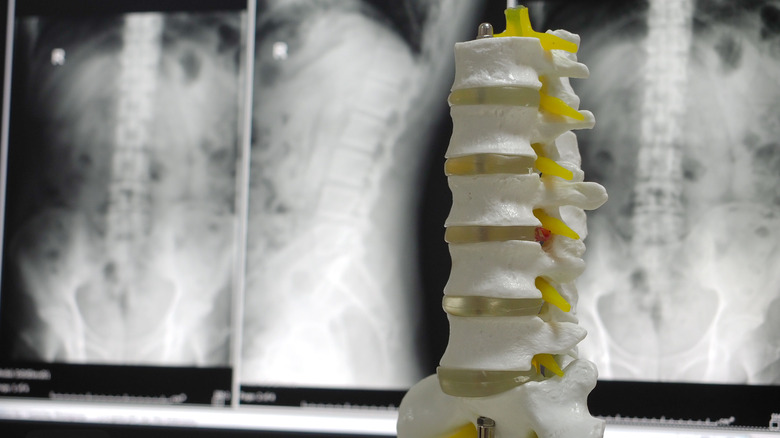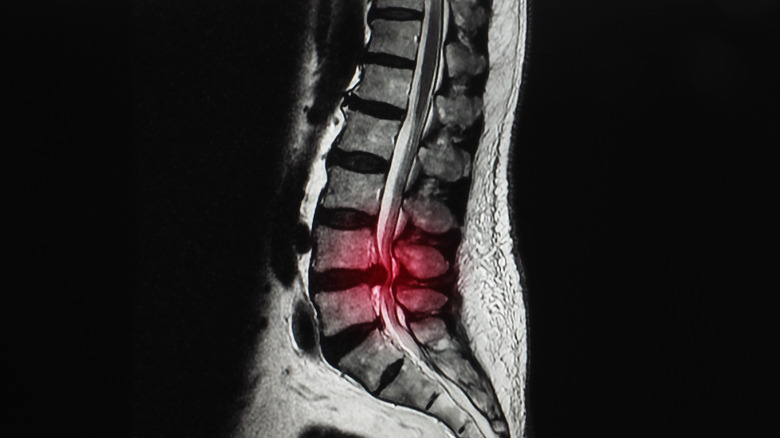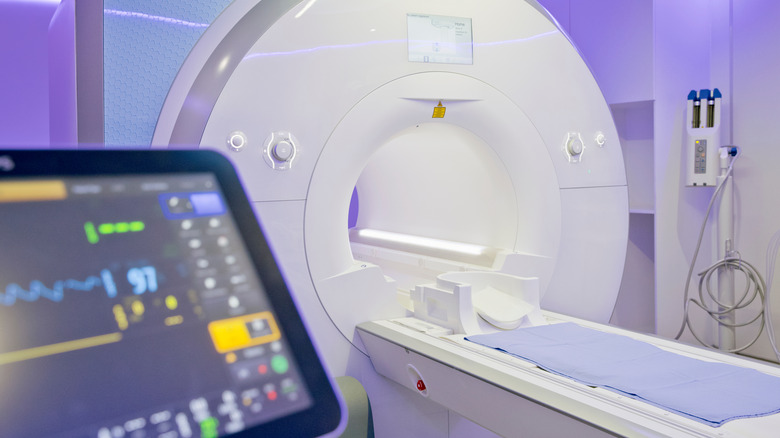Whoopi Goldberg's Nerve Pain Condition Explained
Whoopi Goldberg returned to "The View" on Tuesday, June 29, after a week-long hiatus and provided her fans and co-hosts with a long-awaited health update. Explaining her absence from the show, the actress and television personality revealed that she has sciatica and is now using a walker (via People).
"Yes, it's me, I'm back," Goldberg said on the talk show. "I was out because I was dealing with something called sciatica, which is basically a bulging disc in your back and it impacts the sciatic nerve, which sends pain down your leg."
Opening up about her condition, she explained that her sciatica pain came out of nowhere and landed her in the hospital last week because she couldn't move her leg. According to Goldberg, using her walker has made it much easier for her to walk and move around. "This is my new best friend," she said, referring to the walker. "I'm just gliding along."
What is sciatica?
Sciatica refers to pain that radiates along the sciatic nerve — the longest nerve in the body. The sciatic nerve starts at the lower end of your spinal cord and extends through your hips, buttocks, and legs (via Healthline). It controls the muscle activity and sensation in your lower legs and feet, which can affect your ability to move and feel your legs. Sciatica is caused by irritation and inflammation of the sciatic nerve, which can occur as the result of an injury. This irritation can cause pain and discomfort in the lower back and lower extremities.
Because sciatica is a direct result of damage or injury to the sciatic nerve, it is not a condition in itself. Rather, it's more of a set of symptoms of an underlying problem. Regardless of the cause, however, sciatica is relatively common. According to health experts from Harvard Medical School, up to 40% of people in the United States will experience sciatica at some point in their lives.
Signs of symptoms of sciatica
Sciatica consists of a number of distinct symptoms that can cause discomfort and pain in your lower body. This pain can range from mild to moderate to severe and typically only affects one side of your body. It can extend from the lower back to the back of the thigh and down through the leg (via Everyday Health). You may also experience pain in your foot.
While it can affect everyone differently, the hallmark symptoms of sciatica include pain in the calf and foot, leg cramps with stabbing pain, a tingling or pins and needles sensation in the leg, and numbness and weakness in the lower back, buttocks, leg, or foot. These symptoms can worsen depending on what you do and how you move. For example, your sciatica pain may become more severe if you move a certain way, stay still, hold your breath, bend backwards, sneeze, cough, or laugh. It may also get worse at night.
What causes sciatica?
Sciatica can be caused by a number of injuries and medical conditions, the most common of which is a herniated disk. This occurs when the inner layer of one of the disks between the vertebrae of your spine bulges or herniates through its outer wall (via Cleveland Clinic). The herniated disk can then put pressure on the sciatic nerve, resulting in discomfort and pain.
Another cause of sciatica is spondylolisthesis — a spinal condition that affects the lower vertebrae. Spondylolisthesis occurs when one of the vertebrae in your spine slips out of place and onto the vertebra below it. This can cause the extended spinal bone to your pinch your sciatic nerve. Sciatica can also be caused by spinal stenosis, which is characterized by an abnormal narrowing of the spinal canal in your lower back. This can put pressure on both the spine and the sciatic nerve, resulting in irritation and pain.
How is sciatica diagnosed?
In order to diagnose sciatica, your doctor will need to review your medical history and give you a physical exam. The physical exam will reveal where you feel pain on your body and how it feels. During the exam, your doctor will most likely check your strength and reflexes by asking you to repeat a series of stretches and exercises (via Mayo Clinic). If your pain is severe enough, your doctor may order imaging tests to determine the source and cause of the pain. These tests can include an X-ray, magnetic resonance imaging (MRI), a computed tomography (CT) scan, or electromyography (EMG).
A spinal X-ray will check for bone spurs or other growths that may be pressing on your sciatic nerve, while an MRI or CT scan will produce and scan detailed images of your spine that will highlight your bones, soft tissue, nerves, and spinal cord. An EMG, on the other hand, will measure how well your muscles respond to electrical activity produced by your nerves.
How to treat sciatica
If your sciatica is mild enough, you may be able to treat it at home with a handful of easy, self-care measures. For instance, you can treat your sciatica pain by applying an ice pack to the affected area for 20 minutes at a time (via Cleveland Clinic). This will help reduce your pain and swelling. If this doesn't work, you can try alternating between cold packs and hot packs. You can also take over-the-counter medicines to treat your sciatica. Medications like ibuprofen and naproxen can help reduce pain and inflammation. Stretching may also provide some relief.
For many cases of mild or moderate sciatica, these treatments should help your symptoms improve after six weeks or so. If you don't see any improvement, however, your doctor may recommend medical intervention. More aggressive treatments for sciatica include physical therapy, prescription medications, spinal injections, or acupuncture. In some cases, surgery may even be required.






